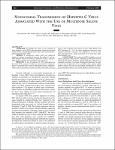Nosocomial Transmission of Hepatitis C Virus Associated With the Use of Multidose Saline Vials
Krause, Gérard
Trepka, Mary Jo
Whisenhunt, Robert S.
Katz, Dolly
Nainan, Omana
Wiersma, Steven T.
Hopkins, Richard S.
Objective: To identify the source of an outbreak of acute hepatitis C virus (HCV) infection among 3 patients occurring within 8 weeks of hospitalization in the same ward of a Florida hospital during November 1998. Design: A retrospective cohort study was conducted among 41 patients hospitalized between November 11 and 19, 1998. Patients' blood was tested for antibodies to HCV, and HCV RNA-positive samples were genotyped and sequenced. Results: Of the 41 patients, 24 (59%) participated in the study. HCV genotype lb infections were found in 5 patients. Three of 4 patients who received saline flushes from a multidose saline vial on November 16 had acute HCV infection, whereas none of the 9 patients who did not receive saline flushes had HCV infection (P = .01). No other significant exposures were identified. The HCV sequence was available for 1 case of acute HCV and differed by a single nucleotide (0.3%) from that of the indeterminate case. Conclusion: This outbreak of HCV probably occurred when a multidose saline vial was contaminated with blood from an HCV-infected patient Hospitals should emphasize adherence to standard procedures to prevent blood-borne infections. In addition, the use of single-dose vials or prefilled saline syringes might further reduce the risk for nosocomial transmission of blood-borne pathogens.
No license information
Related Items
Show related Items with similar Title, Author, Creator or Subject.
-
2022-01-14ZeitschriftenartikelEpidemiologie der Virushepatitiden A bis E in Deutschland Dudareva, Sandra; Faber, Mirko; Zimmermann, Ruth; Bock, C.-Thomas; Offergeld, Ruth; Steffen, Gyde; Enkelmann, JuliaMit Virushepatitis A bis E werden verschiedene infektiöse Entzündungen des Leberparenchyms bezeichnet, die durch die Hepatitisviren A bis E (HAV, HBV, HCV, HDV und HEV) ausgelöst werden. Zwar ähneln sich die Krankheitsbilder, ...
-
2022-01-14ZeitschriftenartikelEpidemiologie der Virushepatitiden A bis E in Deutschland Dudareva, Sandra; Faber, Mirko; Zimmermann, Ruth; Bock, Claus-Thomas; Offergeld, Ruth; Steffen, Gyde; Enkelmann, JuliaMit Virushepatitis A bis E werden verschiedene infektiöse Entzündungen des Leberparenchyms bezeichnet, die durch die Hepatitisviren A bis E (HAV, HBV, HCV, HDV und HEV) ausgelöst werden. Zwar ähneln sich die Krankheitsbilder, ...
-
2015-07-06ZeitschriftenartikelOccult Hepatitis B Virus Infection in Nigerian Blood Donors and Hepatitis B Virus Transmission Risks Oluyinka, Opaleye O.; Tong, Hoang Van; Tien, Sy Bui; Fagbami, Ademola H.; Adekanle, Olusegun; Ojurongbe, Olusola; Bock, Thomas; Kremsner, Peter G.; Velavan, Thirumalaisamy P.Background: Occult hepatitis B virus infection (OBI) characterized by the absence of detectable HBsAg remains a potential threat in blood safety. We investigated the actual prevalence, viral factors and genotype of OBI ...

